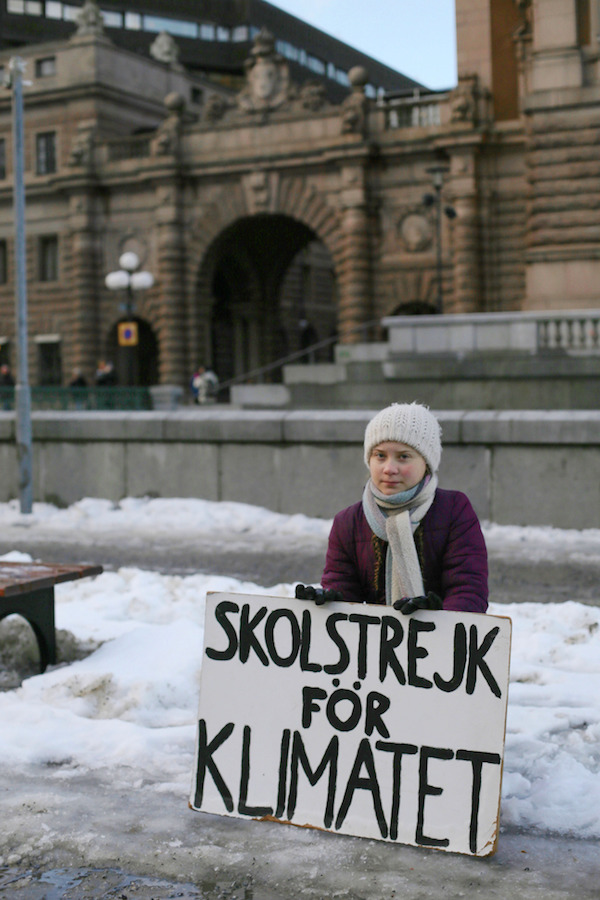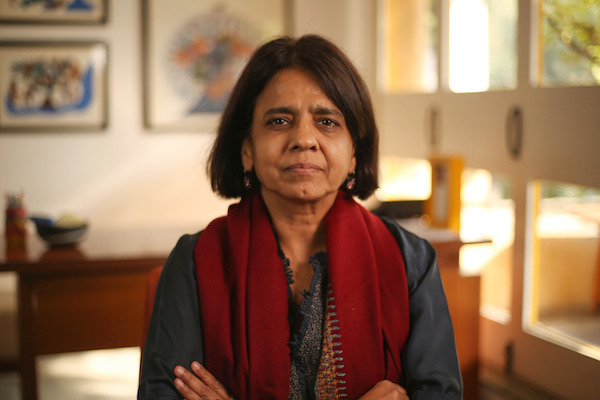Climate Change: The Facts, BBC One review - how much reality can humankind bear? | reviews, news & interviews
Climate Change: The Facts, BBC One review - how much reality can humankind bear?
Climate Change: The Facts, BBC One review - how much reality can humankind bear?
What's driving climate change and how long we have to do something about it

Peer down the glassy dark and you’ll see them. White bubbles trapped in the frozen lake which appear to be rising to the surface. Look through the permafrost this way and you’re seeing into the past: as the ice melts, gas which was captured and stored tens of thousands of years ago when woolly mammoths and sabre-toothed cats stalked Alaska is released into the atmosphere. Each slick of melt water is another decade returning to the rivers.
It’s a bitter irony that David Attenborough, who began his career flush with the ability to convey the wonders of the natural world, is now, at 92, warning of its imminent demise. In his latest programme, Climate Change: The Facts, devastating footage of last year’s climactic upheavals makes surreal viewing — typhoons, forest fires, storm surges, mirages sunrises.
 A car drives along a spit of road - now a kind of bridge - through swathes of submerged land in Indiana. An iceberg calves and upends itself; runnels of water carve channels through a glacier. A forest floor in Australia is littered with mewling black lumps, bats killed by a heatwave with their offspring still alive and clinging to their corpses. Lined up in rows they look like bodies bagged after a massacre. A father and son drive through a forest fire, their journey and increasingly frightened interchanges captured by the dash cam; around them is hell. Families wade through thigh deep water submerging a city in Kerala, guided by ropes to which they cling against flood currents.
A car drives along a spit of road - now a kind of bridge - through swathes of submerged land in Indiana. An iceberg calves and upends itself; runnels of water carve channels through a glacier. A forest floor in Australia is littered with mewling black lumps, bats killed by a heatwave with their offspring still alive and clinging to their corpses. Lined up in rows they look like bodies bagged after a massacre. A father and son drive through a forest fire, their journey and increasingly frightened interchanges captured by the dash cam; around them is hell. Families wade through thigh deep water submerging a city in Kerala, guided by ropes to which they cling against flood currents.
These images only show what has already happened. Interviews with professors (including Professor James Hansen, pictured below, who testified before American Congress on global warming in 1988), government officials, environmentalists, academic and field researchers, and industry spokespeople which drive and structure the programme articulate these changes and project them into the future.
Before humans began burning coal, atmospheric concentrations of CO2 stood at 280 parts per million; they now stand at over 400 parts per million. Around 8% of wildlife is estimated to be at threat of extinction. Sea levels have risen by about 20cm in the last 100 years and could rise by 80cm-1m by the end of the century, engulfing agrarian villages and urban metropolises alike and causing economic chaos. The first climate refugees in America are being relocated; Pacific Islanders' birthplaces will soon be lost to the waves. A third of the world’s coral has already bleached and died. Even the optimistic end of current models promise a ravaged and unfamiliar planet by the end of this century is predicted to be between 3-6˚C hotter.
 A bleak picture emerges of the scale of the damage already wreaked and the urgency of the action required to slow — let alone pause — catastrophe. The targets set by the 2015 Paris Agreement (to keep global temperatures below +2˚C and as close to +1.5˚C as possible) require emissions to drop to net 0% by 2050. The last time the world had current levels of CO2 concentrated in the atmosphere was around 3 million years ago, when temperatures were 2-3˚C hotter than pre-industrial levels and sea levels significantly higher. The forebears of Homo Sapiens lived but the comparison shows just how fragile human life is: while Earth has survived radical climactic changes and regenerated following mass extinctions, it’s not the destruction of Earth that we are facing, it’s the destruction of our familiar, natural world and our uniquely rich human culture.
A bleak picture emerges of the scale of the damage already wreaked and the urgency of the action required to slow — let alone pause — catastrophe. The targets set by the 2015 Paris Agreement (to keep global temperatures below +2˚C and as close to +1.5˚C as possible) require emissions to drop to net 0% by 2050. The last time the world had current levels of CO2 concentrated in the atmosphere was around 3 million years ago, when temperatures were 2-3˚C hotter than pre-industrial levels and sea levels significantly higher. The forebears of Homo Sapiens lived but the comparison shows just how fragile human life is: while Earth has survived radical climactic changes and regenerated following mass extinctions, it’s not the destruction of Earth that we are facing, it’s the destruction of our familiar, natural world and our uniquely rich human culture.
This is a point the programme touches on, albeit lightly. Future climactic changes will precipitate political instability, social upheaval and the mass movement of people escaping drought, famine and flooding on a scale never before been seen. Whether human kind can survive this, let alone the vicissitudes of climate change, is a valid question. We may yet in more ways than one be the originators of our own demise.

Who knows if any or all of these will make a difference in time. The danger is of hitting a tipping point whereby an irreversible process is triggered and emissions spiral out of control. Back to those white bubbles. If the permafrost melts, the methane release will be one of those tipping points. Terminal. To look into the depths of the Alaskan permafrost is therefore also to scry the future. Fear it — this methane, that fire, could be what it holds.
rating
Explore topics
Share this article
Add comment
The future of Arts Journalism
You can stop theartsdesk.com closing!
We urgently need financing to survive. Our fundraising drive has thus far raised £49,000 but we need to reach £100,000 or we will be forced to close. Please contribute here: https://gofund.me/c3f6033d
And if you can forward this information to anyone who might assist, we’d be grateful.

Subscribe to theartsdesk.com
Thank you for continuing to read our work on theartsdesk.com. For unlimited access to every article in its entirety, including our archive of more than 15,000 pieces, we're asking for £5 per month or £40 per year. We feel it's a very good deal, and hope you do too.
To take a subscription now simply click here.
And if you're looking for that extra gift for a friend or family member, why not treat them to a theartsdesk.com gift subscription?
more TV
 Mr Scorsese, Apple TV review - perfectly pitched documentary series with fascinating insights
Rebecca Miller musters a stellar roster of articulate talking heads for this thorough portrait
Mr Scorsese, Apple TV review - perfectly pitched documentary series with fascinating insights
Rebecca Miller musters a stellar roster of articulate talking heads for this thorough portrait
 Down Cemetery Road, Apple TV review - wit, grit and a twisty plot, plus Emma Thompson on top form
Mick Herron's female private investigator gets a stellar adaptation
Down Cemetery Road, Apple TV review - wit, grit and a twisty plot, plus Emma Thompson on top form
Mick Herron's female private investigator gets a stellar adaptation
 theartsdesk Q&A: director Stefano Sollima on the relevance of true crime story 'The Monster of Florence'
The director of hit TV series 'Gomorrah' examines another dark dimension of Italian culture
theartsdesk Q&A: director Stefano Sollima on the relevance of true crime story 'The Monster of Florence'
The director of hit TV series 'Gomorrah' examines another dark dimension of Italian culture
 The Monster of Florence, Netflix review - dramatisation of notorious Italian serial killer mystery
Director Stefano Sollima's four-parter makes gruelling viewing
The Monster of Florence, Netflix review - dramatisation of notorious Italian serial killer mystery
Director Stefano Sollima's four-parter makes gruelling viewing
 The Diplomat, Season 3, Netflix review - Ambassador Kate Wyler becomes America's Second Lady
Soapy transatlantic political drama keeps the Special Relationship alive
The Diplomat, Season 3, Netflix review - Ambassador Kate Wyler becomes America's Second Lady
Soapy transatlantic political drama keeps the Special Relationship alive
 The Perfect Neighbor, Netflix review - Florida found-footage documentary is a harrowing watch
Sundance winner chronicles a death that should have been prevented
The Perfect Neighbor, Netflix review - Florida found-footage documentary is a harrowing watch
Sundance winner chronicles a death that should have been prevented
 Murder Before Evensong, Acorn TV review - death comes to the picturesque village of Champton
The Rev Richard Coles's sleuthing cleric hits the screen
Murder Before Evensong, Acorn TV review - death comes to the picturesque village of Champton
The Rev Richard Coles's sleuthing cleric hits the screen
 Black Rabbit, Netflix review - grime and punishment in New York City
Jude Law and Jason Bateman tread the thin line between love and hate
Black Rabbit, Netflix review - grime and punishment in New York City
Jude Law and Jason Bateman tread the thin line between love and hate
 The Hack, ITV review - plodding anatomy of twin UK scandals
Jack Thorne's skill can't disguise the bagginess of his double-headed material
The Hack, ITV review - plodding anatomy of twin UK scandals
Jack Thorne's skill can't disguise the bagginess of his double-headed material
 Slow Horses, Series 5, Apple TV+ review - terror, trauma and impeccable comic timing
Jackson Lamb's band of MI5 misfits continues to fascinate and amuse
Slow Horses, Series 5, Apple TV+ review - terror, trauma and impeccable comic timing
Jackson Lamb's band of MI5 misfits continues to fascinate and amuse
 Coldwater, ITV1 review - horror and black comedy in the Highlands
Superb cast lights up David Ireland's cunning thriller
Coldwater, ITV1 review - horror and black comedy in the Highlands
Superb cast lights up David Ireland's cunning thriller
 Blu-ray: The Sweeney - Series One
Influential and entertaining 1970s police drama, handsomely restored
Blu-ray: The Sweeney - Series One
Influential and entertaining 1970s police drama, handsomely restored

Comments
Obviously individuals think
"In his latest programme,